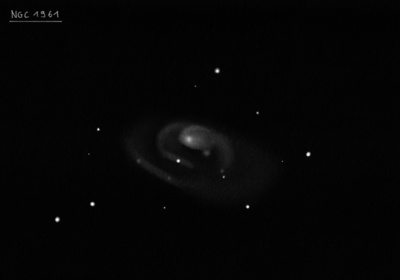
NGC 1961 (also known as IC 2133) is a spiral galaxy in the constellation Camelopardalis. It was discovered by William Herschel on 3 December 1788. It is at a distance of about 200 million light years from Earth, which, given its apparent dimensions, means that NGC 1961 is more than 220,000 light years across. The galaxy has been distorted, however no companion has been detected nor double nuclei that could show a recent merger. Its outer arms are highly irregular. Two long straight arms extent from the north side of the galaxy. A luminous X-ray corona has been detected around the galaxy. NGC 1961 is the central member of the small group of nine galaxies, the NGC 1961 group.Four supernovae have been observed in NGC 1961: SN 1998eb (type Ia, mag. 17.8), SN 2001is (type Ib, mag. 17.6), SN 2013cc (type II, mag. 17), and SN 2021vaz (type II, mag. 17.5).
200/250mm - 8" (10/13/81): faint, moderately large, bright core, diffuse, elongated, star involved.
400/500mm - 17.5" (12/8/90): moderately bright, moderately large, elongated 2:1 E-W, weak concentration, small bright core. A mag 13 star is 30" SSE of center and a mag 12 star is just off the west edge, 2.4' from center. There appears to be a dark patch between this star and the core. Forms a pair with CGCG 329-011 7.6' NE (not seen).
600/800mm - 24" (2/18/20): at 375x; fairly bright, very large, elongated 5:3 ~E-W, contains a bright elongated nucleus that is oddly offset towards the north side. The halo has a low, but uneven surface brightness (due to spiral arms and dust) and extends nearly 3.5'x2.0', though it fades imperceptibly into the sky. A mag 13.5 star is superimposed 30" SSE of center. CGCG 329-011, located 8' NE, appeared very faint, small, round, 20" diameter, low surface brightness. A mag 15.3 star is 20" S.
900/1200mm - 48" (10/23/11): at 375x, this distorted spiral appeared very bright, very large oval nearly 2:1 E-W, ~3.6'x2.0', highly asymmetric appearance. Contains a very bright, large oval core that is clearly offset to the north side of the galaxy! A large arm sweeps E-W along the south side of the halo. A broad dust lane runs parallel to the arm on the inside. Surrounding the core are shorter inner spiral arms including an arm just north of the core that sweeps west and bends south. A mag 13.5 star is superimposed just inside the dust lane, 30" SSE of center.